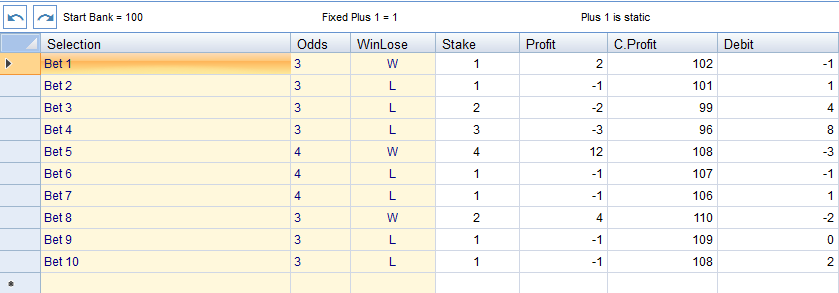Pro Staking Plan
- Yes: 20th Nov,2019: We will show you how investing £100.00 on 20 short priced sports bets returned £9,111.00 Profit. Watch the videos, and see it working.
- This plan will add one unit after one loss. If you are betting 10 units, then the next bet (only after a losing bet) would be 20 units. After one win the stake will stay the same if the last stake is the same as the starting stake, or will decrease by the% if the last stake was bigger than the start stake.
The staking plan you choose is an extremely important part of the quest to create a winning betting strategy. As we all know, bad luck and variation can lead to bankruptcy even if you are really good at finding valuable wagers. This means that bankroll management is the key to success for every bettor out there. It provides protection against bad streaks and it’s a tool to maximize your profits.
Staking ETH permits the staker to act as a validator on Ethereum’s proof-of-stake Beacon Chain, support the Ethereum 2.0 upgrade and be eligible to earn staking rewards. ETH2.S cannot be un-staked and neither ETH2.S nor ETH2 may be transferred on the Ethereum network at this time. Simple staking plan for lay bets. Here's the simplest staking plan which can be used as a base for many other plans. It's key-note is adding the loss from the previous bet to the next bet's size. It proceeds this way until the stake has reached the specified maximum value, after which the bet is fixed. This staking plan is unique to the 2 horse race placers. It has profited since 2013 when used in tandem with 2 horse race placer selections, as long as their odds are between 1.1 and 1.5 decimal odds.
One of the main fundamentals of successful capital management is to determine if you are going to use the same bet size each time or try variable stakes. Both approaches have their strengths and weaknesses so neither is universally better. It highly depends on your general strategy, the way you discover value and select your bets. I will try to summarize the pros and cons of each option and give you some examples where one of them is better than the other.

Before that, I would like to remind you the following: consider your bet size as a percentage of your bankroll, not as a fixed amount. It doesn’t matter if you choose flat or variable stakes, always adjust the size to your overall money. Most pros recommend placing max 3-5% on a single wager. If you can reload at any given moment, you can bet more, but it is probably not the best idea.
Going for Flat Stakes
Lots of tipsters use this approach and place exactly the same amount each time. It certainly has its advantages and one of them is its predictability. It is generally a solid way to see how you are doing as it leaves no room for error such as placing more on a losing bet that wipes out your hard-earned winnings.
However, it can lead to less flexibility and missed opportunities. You should use this approach if most of your betting picks have a similar value expectation and price. This is usually valid for people who rely predominantly on stats and formulas to select their matches.
Let’s say you found some kind of system based on previous results that works in the following way: you put some stats in an Excel formula and it shows you that the Asian Handicap line for a certain game contains value. Most of the time you will be placing your money on odds of about 2.00 and with similar value expectations. This is a textbook case of a strategy that thrives on flat staking.
Going for Variable Stakes
The other way to go is to place different stakes on your bets. Usually, this means using a 5 or 10 units system where the difference between your wagers could reach 10 times. As you would expect, this requires very clear criteria, lots of experience and good reasoning. Simply put – it is more rewarding than flat staking, but also much harder to manage successfully.
The main two factors you should consider are the expected value of your bet and the win probability. As you can assume, the higher the value and the probability, the bigger the stake should be. The most popular staking strategies are based on that logic. The best example is the so-called Kelly Criterion, but there are others as well.
However, determining the value correctly might be an issue and here is where the key moment lies. If you can evaluate your mathematical expectation correctly, you should use variable stakes as it increases your winnings by placing more money on more profitable picks. If you can’t though, the effect could be exactly the opposite.
The probability part is rather straight forward as the odds of a certain event are a good indicator in this regard. You don’t want to risk large chunks of your bankroll on stuff that have like 10-15% chance of happening even if the odds contain great value. If you are unlucky for a while, you can easily lose lots of money doing so.
Conclusion
The general conclusion is that the flat stakes plan is for more straightforward strategies and inexperienced players as it provides a stable and disciplined approach. It is also the best way to test if a certain new strategy is profitable in the long run as variable stakes might skew the real results if you get lucky.
When you feel confident enough with your general betting system, you could try and experiment with variable stakes. See If you can improve your profits by recognizing your best picks and risking more on them.
Whatever you decide, don’t forget that discipline is essential for success. It wouldn’t matter what stakes you’re using if you get angry after losing 2-3 picks in a row and place half of your bankroll in a desperate attempt to make it up, would it?
13 step horse racing staking plan
There are many methods and horse racing systems that are out there for sale. Some are very easy to do for fun and some almost require a mathematician to figure out. Some work very good and some are like throwing a dart blindfolded. This horse racing staking system has been around for ages.
Its to this date one of the most effective systems created and very easy simple to use. It does require some work on your part and you have to be consistent with it. This horse racing system requires extreme patience which is the hardest part to accomplish. Here it is and you can thank me later.

Winning long term is what we are after and this systems does just that:
1.) Do not bet 7, 8, 9 races in one meeting. There are thousands that do this and end up ultimately losing money.
2.) Go to a meeting looking for the one prime opportunity to place one good bet. Have patience if the opportunity is not there then don’t bet.
3.) Only consider races that have 8 to 12 runners-> no more and no less.
4.) The first step is to read all your meetings in your DRF/paper or favorite website.
5.) Scrub the track or tracks go through one meeting at a time and throw out races with more than 12 runners. If a race has only 8 runners than your selection only has to beat 5 to be placed. If there are 9 runners it has to beat 6 horses and odds against him increase 20%. 10 runners have to beat 7 and odds against you increase 40%. Bigger the field say 16 runners now you have to beat 13 runners and odds are against 160%. So you can see how odds stack up against you with each additional horse. So max is 12 runners now you have diminished some races and this will slow your game down and give you more thought time on the other races.
6.) If you have horses in the race that have no form or are first timers with no form discard this race
7.) Keep in mind if we are place betting we will only collect a dividend if the horse comes in 1st or 2nd. It isa smaller dividend than the outright win but over time these place victories will pay off. You are going after place success so you will hit more races than a straight win and develop a consistency of success.
8.) Now resort to the racing paper you usually use or website that you usually view. Also buy different analysis of the race publications and compare against each other. If 3 0r 4 different sources cannot come to agreement on 2 horses then throw this race out.
Lay Pro 88 Staking Plan

9.) When you have a consensus of 1 or 2 horses look at the comments they say about him/her. Take notice of really hot favorites to win many times the paper or your source will make comments like cannot lose or this is the one to beat. Also look at the negative comments for other horses like “not this time” or “nothing positive.”
10.) Also make sure the horse has a good jockey if the jockey is almost unheard of then this could be a deal breaker. You need a reputable or solid jockey on this favorite horse.
11.) You want the good, hard, or fast track condition or throw the race out.
12.) You want the horse to be high up close to the rail like 1st thru 4th position.
Pro Staking Planter

13.) If after this process you have a horse that stands out and meets all the criteria. Make a fairly large to your comfort level place bet.
This is a great program for winning consistently at the track. Monitor the weather to make sure conditions of track does not change. When you work hard doing your homework you will probably only have 2 0r 3 selections for the whole week.
You will become a winner with consistent consecutive success with this amazing horse racing staking method.
Share on Facebook